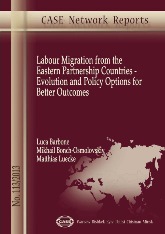Seven studies on labor migration from the EaP countries released
 Since the resolution of the Soviet Union in the 1990s and through the large-scale labor mobility during the 2000s, migration has continued to impact the economies and societies of the Eastern Partnership (EaP) countries. The newest CASE Network Report, titled “Labor Migration from the Eastern Partnership Countries: Evolution and Policy Options for Better Outcomes”, provides a structured overview of labor migration in the six countries, based on the country reports produced under the recently completed project “Costs and Benefits of Labor Mobility between the EU and the Eastern Partner Partnership Countries”. The report examines the existing costs and benefits of migration concerning individual (household) and macroeconomic effects and tries to assess the potential future of migration flows. Basing on the assessment, the authors provide a set of policy recommendations for both the EaP countries and the EU aimed at maximizing benefits from migration flows.
Since the resolution of the Soviet Union in the 1990s and through the large-scale labor mobility during the 2000s, migration has continued to impact the economies and societies of the Eastern Partnership (EaP) countries. The newest CASE Network Report, titled “Labor Migration from the Eastern Partnership Countries: Evolution and Policy Options for Better Outcomes”, provides a structured overview of labor migration in the six countries, based on the country reports produced under the recently completed project “Costs and Benefits of Labor Mobility between the EU and the Eastern Partner Partnership Countries”. The report examines the existing costs and benefits of migration concerning individual (household) and macroeconomic effects and tries to assess the potential future of migration flows. Basing on the assessment, the authors provide a set of policy recommendations for both the EaP countries and the EU aimed at maximizing benefits from migration flows.
Though labor migration concerns all of the EaP countries, there are large differences in the scale of migration between, inter alia, oil-rich Azerbaijan, the urban areas of Belarus and Ukraine, and the rural areas of Georgia and Armenia. The six country studies published in CASE Studies and Analyses provide in-depth analyses of the costs and benefits of labor migration in Armenia, Azerbaijan, Belarus, Georgia, Moldova and Ukraine.
